Edward II of England
Posted on 4th January 2021
Edward was born on 25 April 1284 at Caernarfon Castle in North Wales hence he was known as Edward of Caernarfon, the fourth son of King Edward I of England and Eleanor of Castile.
Two of Edwards brothers had died before his birth and the third died before Edward reached his first birthday; this left Edward as heir to the English throne.
Edward had little contact with his parents during his youth, being raised by a wet-nurse and then a foster mother. An entire household complete with staff was created for Edward, initially managed by Giles of Oudenarde.
It is unsure what education Edward received however, he is not believed to have been a learned man; he was however instructed in military and riding skills and he enjoyed music.
Edward was left as regent of England in 1297 -1298 while his father went on campaign in Flanders against Philip IV of France.
When Edward I returned, he signed a peace treaty with Philip IV and took his sister Margaret as his wife, his first wife Eleanor having died in 1290. It was also agreed that his son Edward would later marry Philip’s daughter Isabella; she was only two years-old at the time.
Edward formed a very close relationship with Piers Gaveston, 1st Earl of Cornwall, which over time became unpopular with King Edward I who exiled Gaveston to Gascony in 1307.
Edward I died on 7 July 1307, and on 20 July Edward II was proclaimed King, however he was never to live up to the formidable King his father had been.
Reign 1307 - 1327
One of Edward II’s first decisions was to recall Piers Gaveston from exile, appoint him Earl of Cornwall and arrange a marriage for him.
In 1308 Edward travelled to France for his marriage to Isabella, leaving Gaveston in charge of England. This decision was very unpopular with the barons.
The marriage of twelve year-old Isabella and Edward took place on 25 January 1308 in Boulogne, France, they then returned to England for their coronation on 25 February 1308 at Westminster Palace, London.
Isabella gave birth to their first son, the future Edward III in 1312, she followed this with three further children.
Gavestons influence over Edward continued to be unpopular with the barons; and they, supported by Isabella exiled Gaveston again. Edward tried to recall Gaveston, but he was thwarted at every turn by the barons. Finally, Edward made arrangements with the Pope, which opened the door for Gavestons return in 1309.
Following his return, the relationship between Gaveston and the barons continued to deteriorate with many refusing to attend parliament in 1310 because of Gavestons presence.
Edward was given no choice but to accept the Ordinances of 1311 which limited his powers without the agreement of parliament. Gaveston, having been exiled again was finally executed on the orders of the Earl of Lancaster on 19 June 1312.
While the barons concentrated on matters at home, Robert the Bruce was strengthening his position in Scotland, capturing many castles and sending raids into northern England. This spurred Edward into action and resulted in the Battle of Bannockburn on 24 June 1314, however this was a resounding success for Robert the Bruce and Scotland. It is known as one of the worse English defeats ever.
Opposition to Edwards rule was growing. His incompetence in government and lack of care for his people suffering from famine made his enemies many.
Following the death of Gaveston, Edward found new favourites in the Despenser family. This caused civil war to break out in 1321 as the barons were unhappy with the reliance of Edward on the Despenser’s advice and support in government.
The barons seized Despenser lands, and Edward fearing being overthrown, was forced by the barons to exile the Despenser family.
Edward gathered an army to oppose the barons and recalled the Despenser family. Edward fought the opposition led by the Earl of Lancaster at the Battle of Boroughbridge in 1322, Lancaster was captured, found guilty of treason and beheaded.
The Ordinances of 1311, were revoked by Edward in 1322. He then set about a new campaign in Scotland, but this ended in a truce being agreed, with Edward recognising Robert the Bruce as King of Scotland.
Edward now turned his attention to improving his relationship with France. He sent his wife Isabella to France to negotiate with her brother, the King. Soon after, her son was sent to join her and a peace treaty was signed with King Philip IV. Isabella and her son were now expected to return to England, but they did not.
Edward having executed the Earl of Lancaster, now found that his main opposition was his own wife Isabella. She and Roger Mortimer, who many believed was her lover decided to invade England with the help of the Count of Hainaut. To gain Hainaut’s support, Isabella agreed a marriage between her son Edward and Hainaut’s daughter.
Isabella and Mortimer landed unopposed in Orwell on 24 September 1326. Many barons supporting Isabella’s decision, joined her invasion. Edward failed to rally support to foil the invasion and he was forced to abdicate his throne in favour of his son, Edward, later to become Edward III.
Isabella’s pure hatred of the Despenser family led her to have Hugh Despenser the Elder executed. Hugh, the younger Despenser was placed on trial, found guilty of treason and executed on 24 November 1326.
The coronation of Edward III finally took place on 2 February 1327 at Westminster Abbey.
Tagged as: Junior Middle Ages
Share this post:





